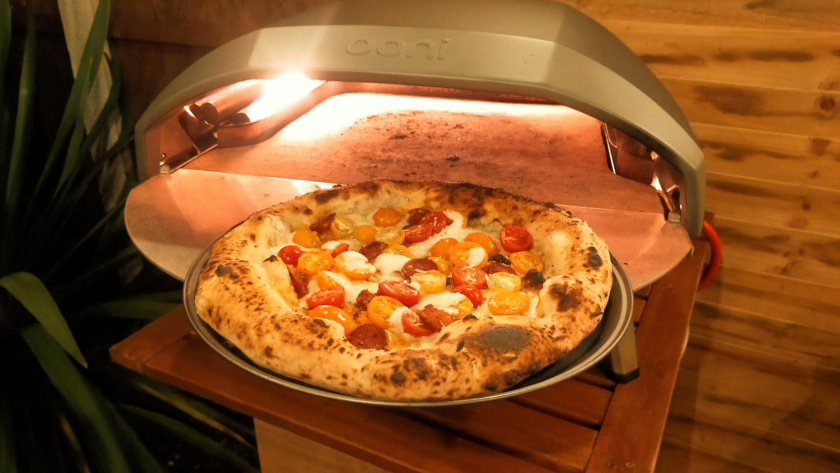Pizza, with its delicious layers of bubbly cheese, flavorful sauce, and an assortment of toppings, is a universally adored delicacy.
Traditionally, achieving that perfectly crisp crust and melted topping required high temperatures only achievable in outdoor brick ovens. However, the evolution of indoor pizza ovens has brought the pizzeria experience to our kitchen countertops.
Types of Indoor Pizza Ovens
Each oven serves a unique purpose, and knowing the differences can make all the difference:
Electric countertop pizza ovens: Perfect for beginners and those short on space. They offer convenience but might lack the authentic smoky flavor.
Built-in indoor wood-fired pizza ovens: For the purist at heart. It’s all about recreating the authentic Neapolitan experience right at home.
Gas-powered indoor pizza ovens: A fusion of tradition and modernity. They promise quick heating without the hassle of wood.
Portable indoor pizza ovens: Ideal for those who enjoy mobile feasts, like a pizza night in the backyard or a picnic.
Benefits of Indoor Pizza Ovens
Indoor pizza ovens, which have gained popularity in both commercial and residential settings, offer numerous benefits:

Consistent Cooking Temperature: Traditional indoor pizza ovens, especially wood-fired and gas ovens, maintain a consistently high temperature, ensuring pizzas cook evenly and quickly.
Authentic Taste: A wood-fired indoor pizza oven imparts a distinct smokey flavor to the pizza, which is hard to replicate in conventional ovens.
Quick Cooking Time: With temperatures reaching up to 800°F (425°C) or higher, pizzas can cook in a matter of minutes, which is much faster than conventional ovens.
Versatility: While they’re known for baking pizzas, these ovens can also be used for roasting meats, baking bread, and other cooking endeavors, making them a versatile kitchen appliance.
Energy Efficiency: High temperatures mean quicker cooking times and, therefore, less overall energy consumption if you’re using the oven for short periods.
Ambiance: There’s something undeniably special about the ambiance a visible flame creates in a kitchen or dining space. It adds a cozy, warm atmosphere that enhances the dining experience.
Increased Home Value: For homeowners, installing a built-in indoor pizza oven can increase the value of the home. It’s seen as a luxury appliance, and potential buyers often view it as a unique selling point.
Durability: Many indoor pizza ovens are constructed with high-quality materials like brick or stone, which can endure high temperatures and have a long lifespan.
Healthier Cooking: High cooking temperatures allow for quick cooking, which can preserve the nutrients in the food better than prolonged cooking at lower temperatures.
Aesthetic Appeal: Indoor pizza ovens can be a centerpiece of a kitchen’s design, adding aesthetic value to their traditional or contemporary looks.
Saves Space: Countertop or built-in indoor pizza ovens can save space as compared to a full outdoor setup, making them ideal for spaces with limited outdoor areas.
Year-round Use: Unlike outdoor ovens, which can be affected by weather conditions, indoor ovens can be used throughout the year.
Safety: Indoor ovens are designed with safety in mind. Properly installed and maintained, they contain high heat efficiently, minimizing the risk of burns or fire hazards.
Professional Results: Many indoor pizza ovens are designed to replicate the results of professional pizza kitchens, allowing homeowners and chefs to produce restaurant-quality pizzas.
While there are undeniable benefits to owning an indoor pizza oven, it’s essential to consider installation requirements, ventilation, and maintenance. If those challenges can be addressed, an indoor pizza oven can be a delightful addition to any culinary space. Explore this Best indoor pizza oven buying guide and safety tips.
Setting Up and Using Your Indoor Pizza Oven
Choosing the Right Spot:
- Ensure adequate ventilation, especially if it’s wood-fired. This may mean installing a vent or chimney.
- Select a location that’s heat-resistant. Stone, tile, or metal surfaces are ideal.
- Make sure there’s enough space around the oven to work comfortably.
- Proper Installation:
- It’s highly recommended to hire a professional, especially for built-in models, to ensure safety and efficiency.
- For electric pizza ovens, ensure you have the right voltage and plug type.
- Ventilation:
- It is crucial for wood-fired ranges to ensure the smoke is efficiently channeled out and fresh air can enter.
- Install a hood or chimney above the stove. Ensure it meets local building codes.



